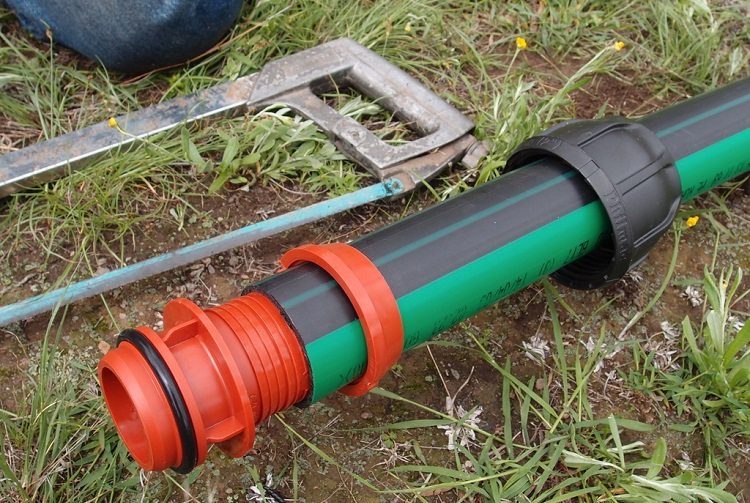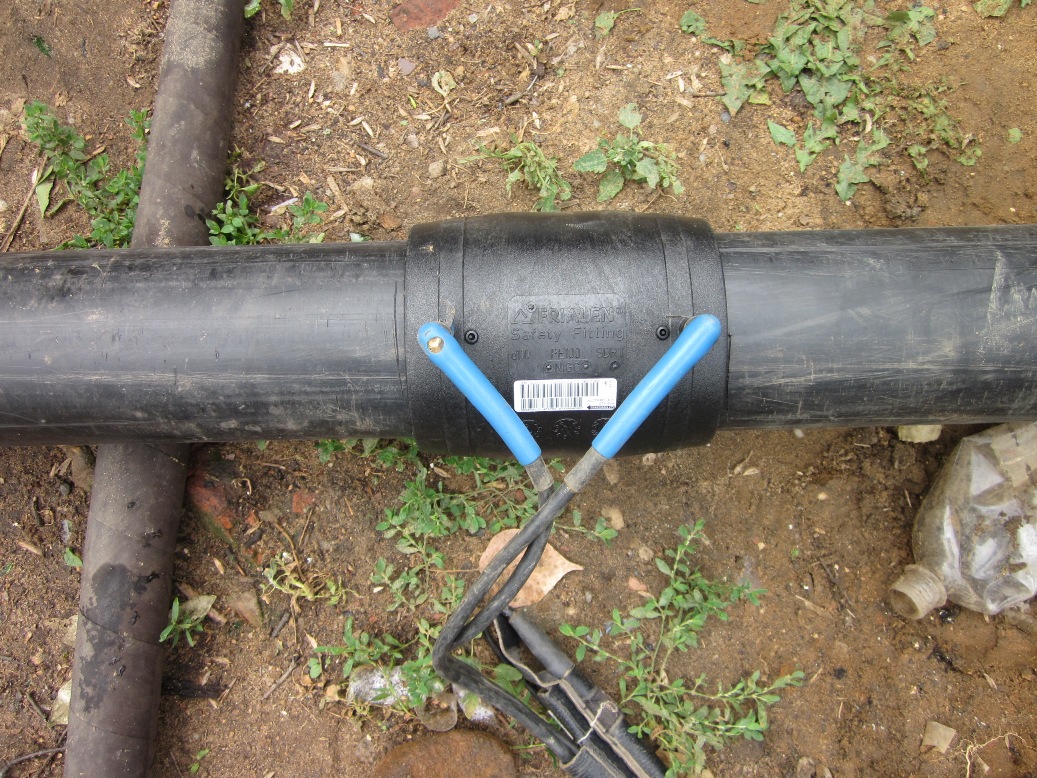DVN-Stroy company performs work on laying polyethylene pipes of various diameters, from 50 to 630 mm.
Polyethylene pipes are widely used in construction. They are used for laying water supply networks, gas distribution systems, pressure and gravity sewerage networks, as protective cases for electrical and telephone cables. Pipe laying is carried out using the traditional open-cut or trenchless method. The production of PE pipes is carried out by continuous extrusion from low pressure polyethylene.
DVN-Stroy uses only. For pipes with a diameter of up to 315 mm, the Italian GF Omicron 315 is used. For pipes 315-630 mm - Ritmo Delta 630. Socket welding is performed using the Hurner HST300.
Methods for installing polyethylene pipes.
Polyethylene pipes are installed mainly in three ways: using butt welding, electrofusion welding with embedded heaters and using compression fittings. Pipe turns and branching are performed using welded or cast fittings: bends, crosses, tees, flange sleeves.
Remoteness of the object;
The presence or absence of electricity, etc.
The cost of work is estimated after reviewing the design documentation or visiting a specialist on the site.
You can also send drawings or a diagram of pipe laying by e-mail [email protected] This will allow us to more accurately estimate the cost of work and materials (polyethylene pipes, bends, fittings, tees, gate valves or ball valves, bushings, flanges, electrofusion couplings), estimate the timing of work.
An example of the installation of polyethylene water pipes.
Most of the city's utilities built during the Soviet era are worn out by 70% or more. Almost all water supply pipelines were made of steel pipeswhich are most susceptible to corrosion. The deterioration of these pipes is expressed in constant emergency situations - pipe breaks, a decrease in the pipe section and its bandwidth, water pollution by biological parameters.
The picture below clearly shows the state of the steel water pipe after a long service life.
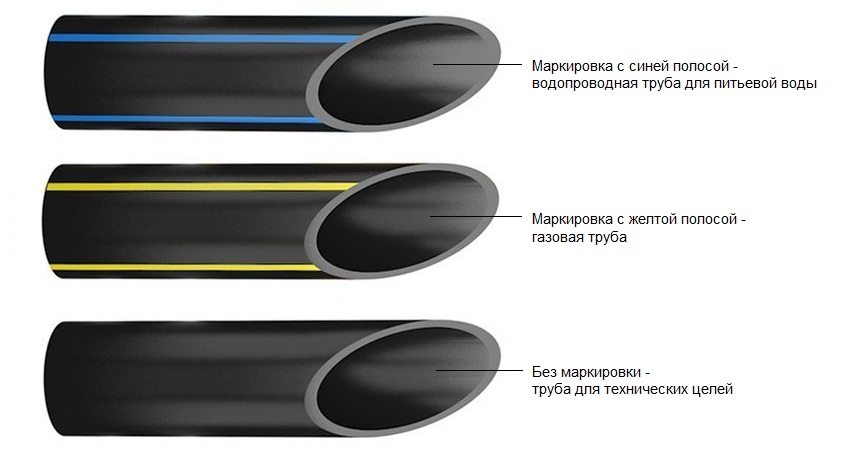
One of the options for the reconstruction of worn out is the laying of polyethylene pipes. Replacement of pipes can be carried out along the old pipe, with destruction, or laid next to the existing pipe, without interrupting the water supply to residential buildings and other consumers. Wells and chambers, depending on the state, are subject to replacement, complete or partial reconstruction (for example, replacement of necks, stairs and hatches).
At the first stage, after completing earthworks for excavating trenches and pits, polyethylene pipes are welded into a whip by butt welding, in a trench or on the ground.


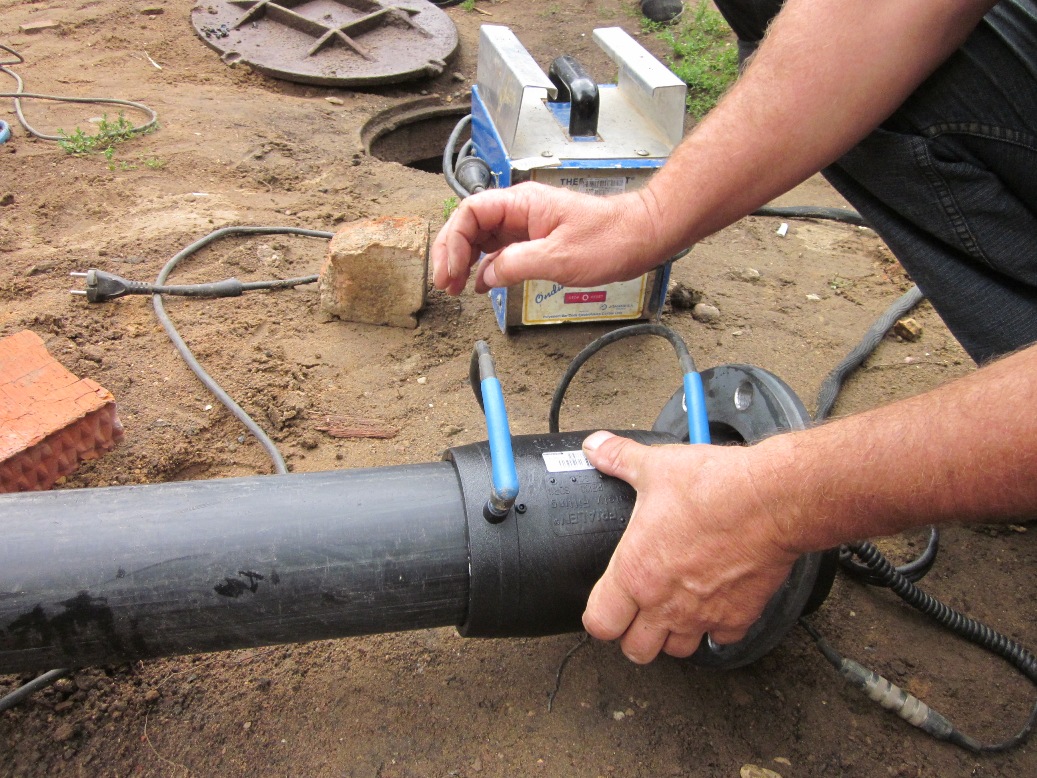
Installation of polyethylene pipes between themselves is performed in the following sequence.
1. Pipes are maximally aligned and centered relative to each other. The surfaces of the pipes are prepared for installation: they are cleaned of dirt and degreased.
2. Tapping into the main pipe can be performed in several ways, for example, using a flanged cast iron tee TF or a plastic tee. The illustration below shows a saddle cut-in option. HDPE bushings with boring flanges are mounted on the ends of the pipes using electrofusion couplings.
It is very important to correctly mount the assembly on a free pipe. The distance between the flanges should be such that in the subsequent installation of the valve and tightening the bolts, the connection would be sufficiently tight. In the future, the connection must withstand hydraulic tests of 8-12 Atm, while polyethylene pipes should not experience unnecessary tensile stresses, which will ensure a long service life of the laid water pipes.
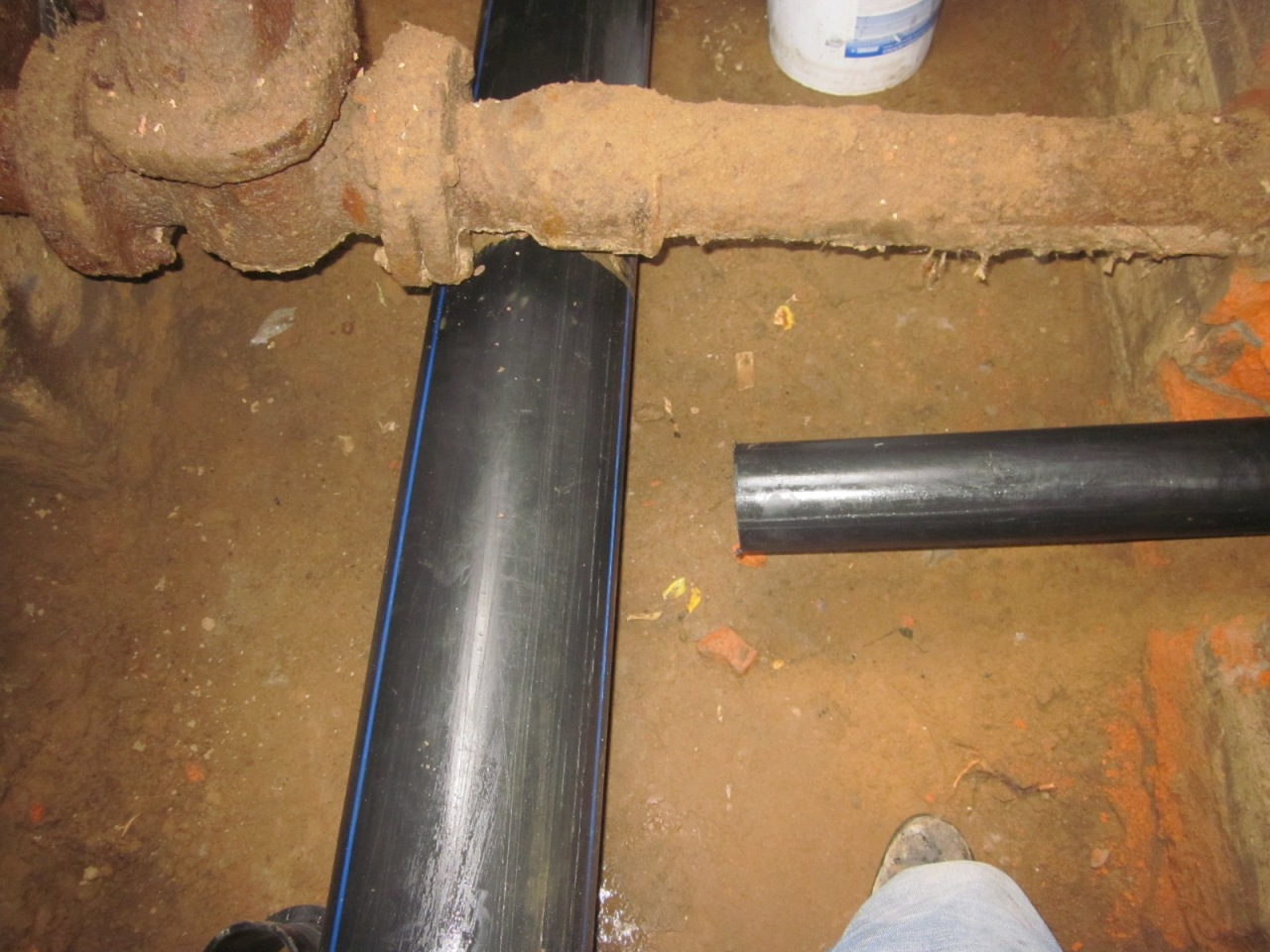
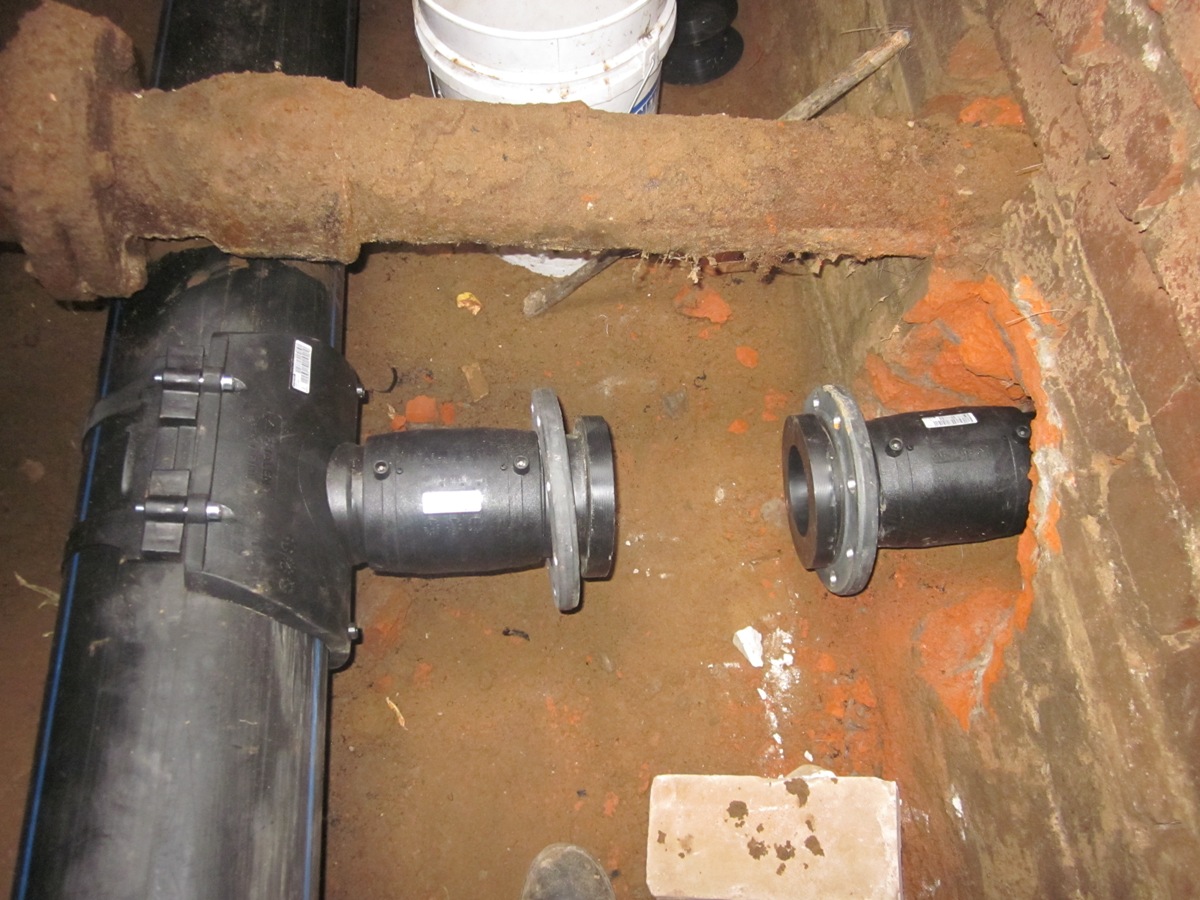
3. Next, the flanged valve is installed. All work is carried out in the existing chamber. After switching the water supply to a new line, old worn out water pipes to be dismantled and washed with cement-sand mortar.

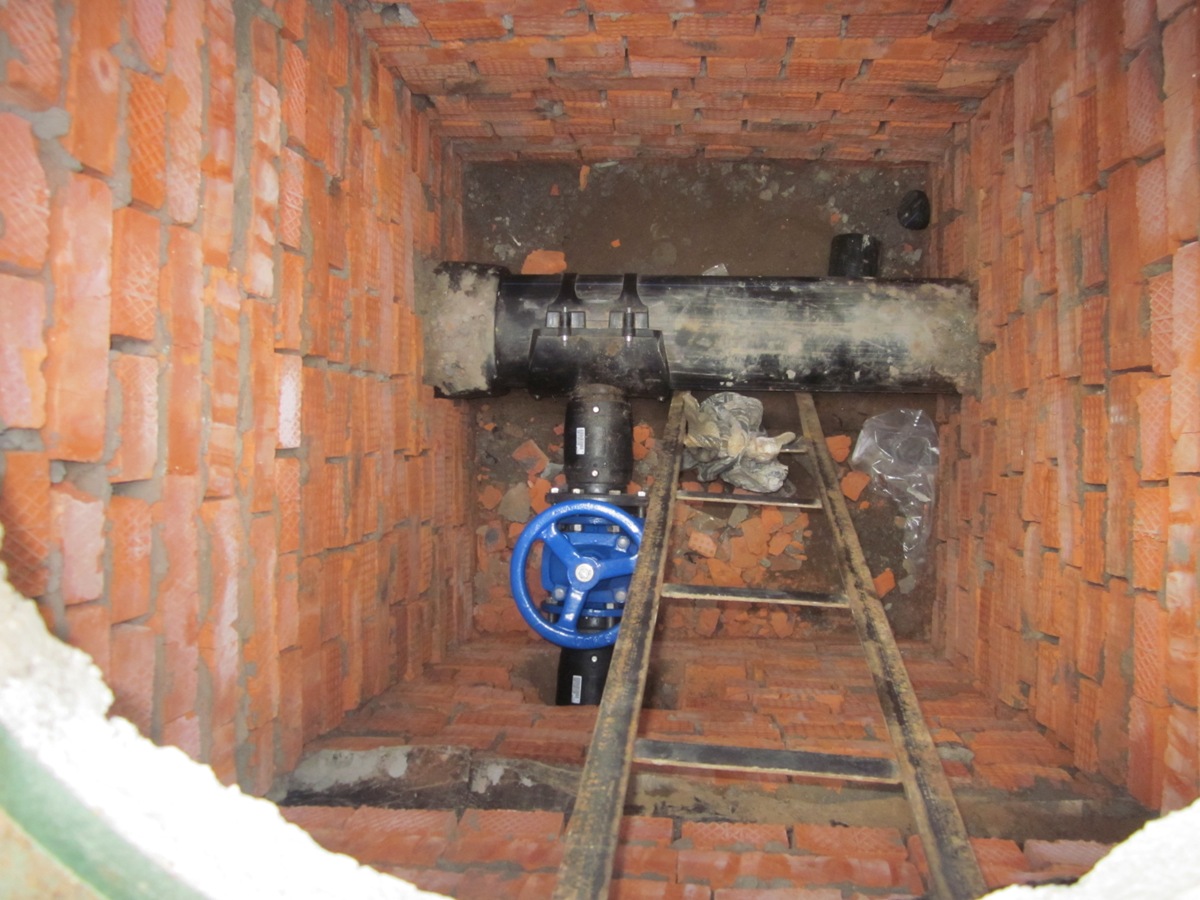
Plumbing made of polyethylene pipes has high performance characteristics. Polyethylene possesses high chemical resistance, is not subject to corrosion and low temperatures. Due to the high smoothness of the pipe walls, their throughput is 25-30% higher than that of steel pipes.
The service life of polyethylene pipelines is at least 50 years.
Rules for laying and installing polyethylene pipes.
When performing underground laying of polyethylene pipes, the following rules must be remembered and observed. The depth of pipe laying should be 0.2 meters deeper than the freezing depth of the ground (in the Moscow region it is 1.5 meters). The width of the trench along the bottom should be 40 centimeters larger than the diameter of the pipe to be laid. If butt welding of HDPE pipes will be carried out in a trench, its width should allow placing a welding machine there.
Before installing pipes, in order to avoid damage to them, the bottom of the trench must be carefully leveled. If the base of the trench has solid inclusions, it is necessary to arrange sand pillow made of sand 10-15 centimeters thick. If necessary, the device of the base and backfilling is eliminated.
Backfilling is carried out after the pipes have been laid. The initial sprinkling is done with sand, 15-30 centimeters above the top of the pipe. Further backfilling to the top of the trench can be done with local soil of stones or debris larger than 20mm. Under the designed roads and driveways, the trench is backfilled exclusively with sand with layer-by-layer compaction.
The advantages of polyethylene pipes.
Modern polyethylene pipes are made of PE80 m PE100 grade polyethylene in accordance with GOST 18599-2001 and have many advantages over other types of pipes:
The cost of polyethylene pipes is lower than steel pipes;
Service life is not less than 50 years;
HDPE pipes are not subject to corrosion, as well as resistant to aggressive media;
Due to the low weight, the installation of polyethylene pipes is carried out without the use of heavy-duty equipment;
Installation of polyethylene pipes by butt or electrofusion welding is simple and reliable;
When water freezes inside the pipe, it does not collapse;
These indisputable properties of polyethylene pipes have allowed them to find wide application in all areas of construction of engineering communications.
Pressure water supply. Material - polyethylene
In what cases does it make sense to use HDPE polyethylene pipes for water supply? What regulatory documents are they produced according to? How is the installation of a polyethylene water pipe carried out? Today we have to find answers to these and some other questions.
Properties of polyethylene
The properties of polyethylene pressure pipes are largely determined by the properties of the polymer itself.
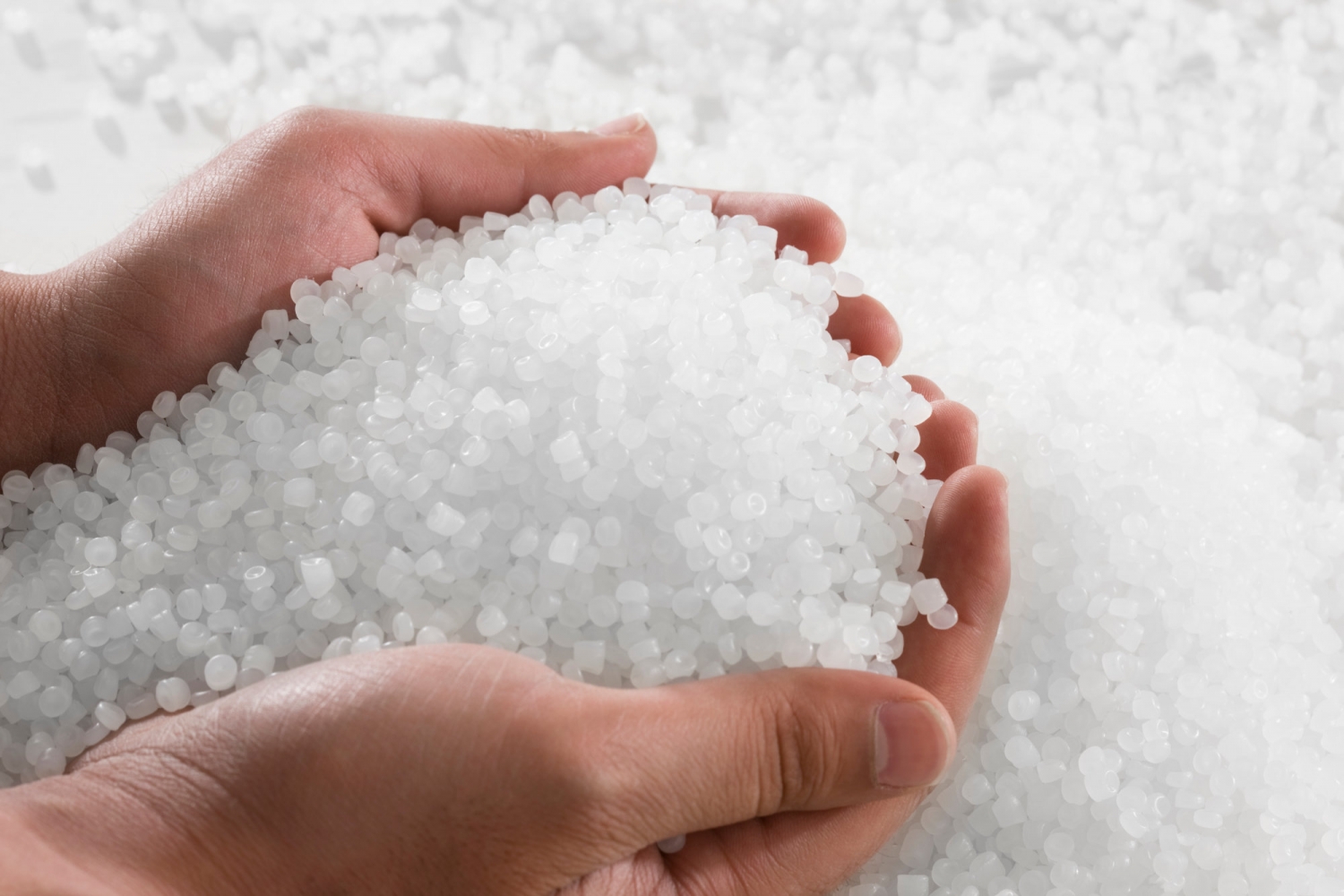
Let's take a look at them.
- At temperatures up to 40-50 ° C, polyethylene is insoluble and does not react with any of the known substances;
It is curious: containers for storing concentrated acids and alkalis are made from this polymer.
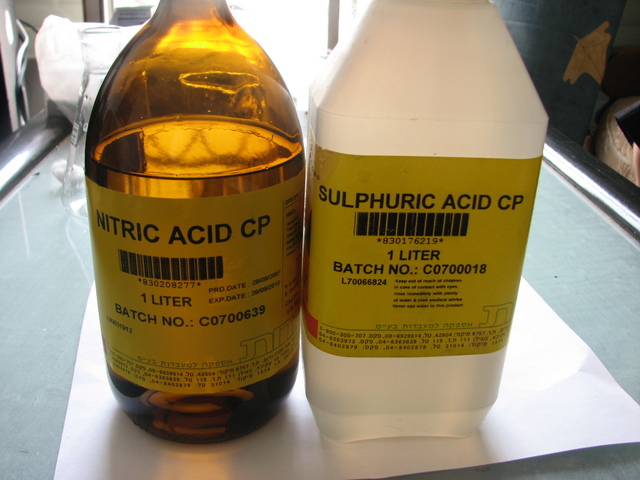
- depending on the production technology, polyethylene of low, medium and high pressure is divided. HDPE (low pressure polyethylene), which undergoes polymerization at an overpressure of 1-20 atmospheres and temperatures up to 150 degrees in the presence of a catalyst, is the most mechanically strong;
Note: as a rule, a polyethylene pipe for water supply is made from HDPE; less durable PSD and LDPE (medium and high pressure polyethylene) are more often used in the production of free-flow sewer pipes.
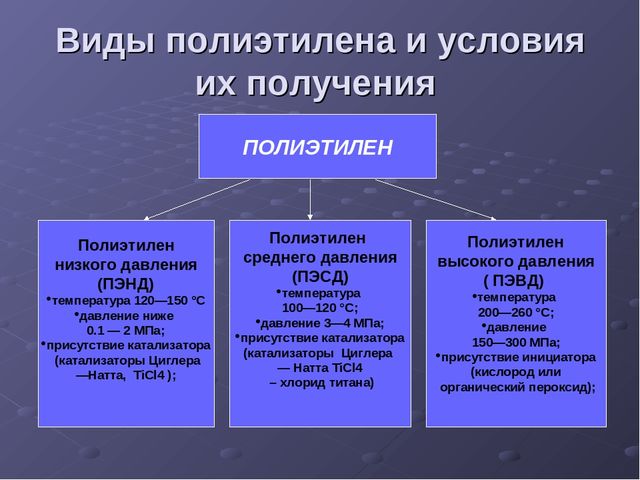
- The polymer is resistant to biodegradation, has zero hygroscopicity (ability to absorb water), but is afraid of ultraviolet radiation. To protect against the ultraviolet component of the solar spectrum, stabilizers and dyes that absorb radiation are added to products made from this polymer.
Standard requirements
In our country, polyethylene pressure pipes are manufactured according to the interstate standard number 18599-2001. That, in turn, is an updated version of the Soviet standard 18599-83.
So, what should be the polyethylene pipes produced in accordance with GOST 18599-2001 for water supply?
Definitions
Let's start with the definitions used throughout the text of the document.
- Nominal outside diameter - outer diameter excluding the tolerances provided by the standard. The inner diameter, which directly affects the throughput of the water supply system, differs from the outer one by twice the thickness of the pipe wall;
- Ovality is the difference between the maximum and minimum diameters measured in one cross section;
- Nominal wall thickness - pipe wall thickness excluding tolerances;
- SDR (Standard Dimensional Ratio) is the result of dividing the nominal outside diameter by the nominal wall thickness. The greater the SDR, the lower the tensile strength of the pipe: as the diameter (and, accordingly, the area of \u200b\u200bthe inner walls) increases, the tensile force on the walls increases with constant internal pressure;
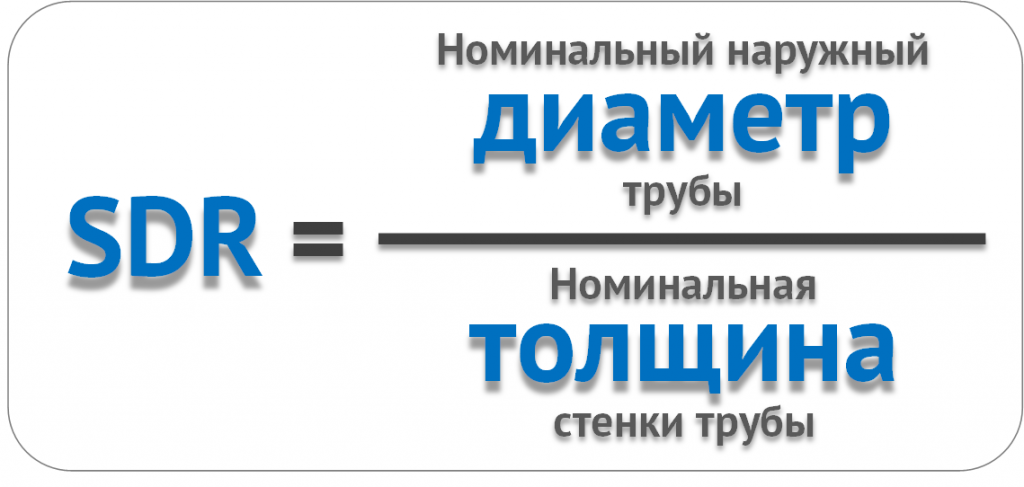
- MOP (maximum working pressure) - the pressure allowed during continuous operation of the pressure water supply;
- PN (nominal pressure) is a numerical designation indicating the mechanical strength of the water supply system and the permissible pressure in it, but taking into account the safety factor.
Dimensions
What diameters of polyethylene pipes for water supply does GOST 18599-2001 provide?
The sizing chart includes diameters from 10 mm to 2 meters with wall thicknesses from 2 to 118 millimeters. Deviations from the nominal diameter and nominal wall thickness are permissible only upward; this requirement ensures that the minimum flow capacity and strength of the water supply system meet the values \u200b\u200bstipulated by the standard.

Polyethylene pipes for water supply can be supplied on spools, in coils over 500 meters long and in straight sections.
However: for diameters over 180 mm, pipes are, for obvious reasons, only supplied in straight lengths. Their length varies from 5 to 24 meters with a multiplicity of a quarter of a meter.
Designation
How are polyethylene pipes marked?
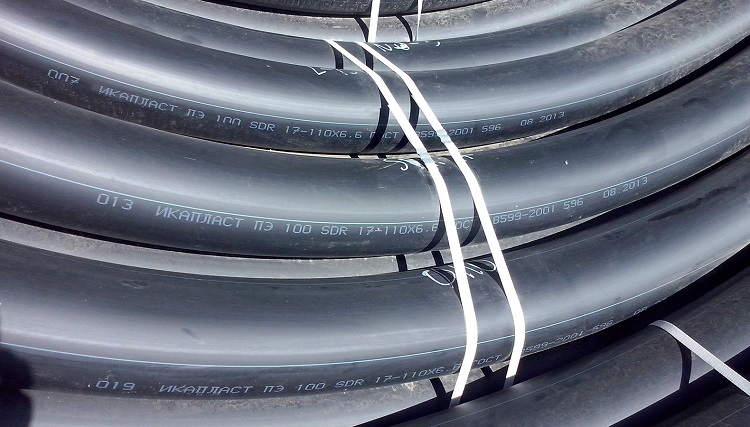
The designation should include:
- The word "pipe";
- Type of polyethylene (PE 32 - PE 100);
Note: the number in the name of the grade of polyethylene indicates its minimum long-term strength. The ability of the material to withstand a load of 3.2 MPa without destruction is typical for PE 32 polyethylene, 8 MPa for PE 80 polyethylene, and so on.
- Outside diameter;
- Wall thickness;
- Purpose of the pipe (drinking or technical);
- Standard designation.
So, the PE 80 SDR 17.6 - 160x9.1 drinking pipe GOST 18599-2001 is made of PE 80 polyethylene, has a nominal outer diameter of 160 mm with walls 9.1 mm thick and is intended for drinking water.
Appearance
Cold water pressure pipes are color coded and can be:
- Black;
- Black with longitudinal blue stripes;
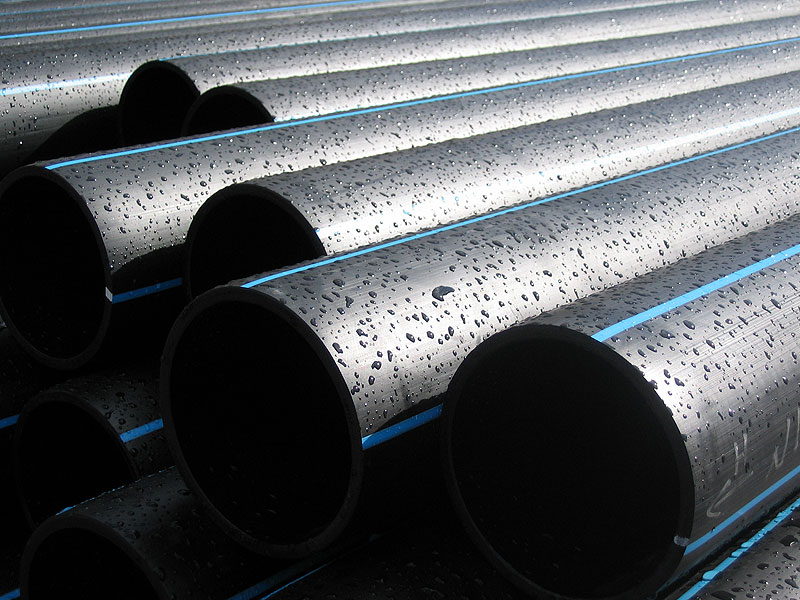
- Blue.
Surfaces (external and internal) should be smooth, free of bubbles, cracks, foreign inclusions and cavities. Only longitudinal stripes and a small wave are permissible - provided that they fit within the permissible deviations from the nominal size and do not lead the pipe beyond the permissible ovality.
Assessment
How good are polyethylene water pipelines compared to competing solutions?
Let's weigh their merits and demerits.
pros
- Huge resource (at least 50 years). For comparison - the estimated service life on cold water is 15 years, galvanized - 30;
However: polypropylene serves in cold water for the same 50 years.
- Resistance to aggressive environments, which allows you to safely lay pipes in the ground;
- As we have already found out, polyethylene is a dielectric. If so, you can forget about the damage to the metal elements of the water supply system by stray currents and electrochemical corrosion;
Note: this property is common to all plastics.
- Polyethylene has no effect on the composition and taste of drinking water. To appreciate this property, remember the characteristic taste of water from a rusty steel plumbing;

- The pipe walls have a perfectly smooth surface and offer minimal resistance to flow. Low hydraulic resistance means that the drop in pressure in the water supply will be minimal;
- The pipe is not overgrown with deposits. After decades of operation, its clearance will not decrease;
By contrast, steel pipelines have to be designed with the inevitable lime and rust overgrowth in mind. The pipe clearance can be halved in the first ten years of the pipeline's service.
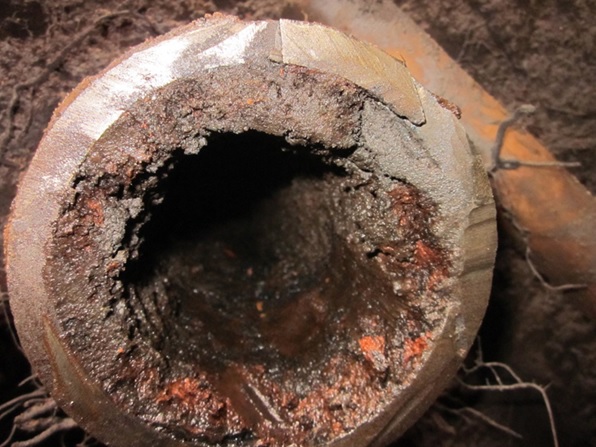
A common problem with steel pipes is reduced throughput due to overgrowth of deposits
- Polyethylene has low thermal conductivity. This means that the temperature of the transported water will remain relatively stable regardless of external conditions;
- The low weight of the pipes simplifies their transportation and installation;
- The considerable length of the bay (500 meters or more) reduces the number of installation connections when laying underground highways of small diameter;
- Butt welding of large diameter pipes does not require any supplies... It only needs electricity;
- Finally, the main thing: polyethylene is elastic, and this property remains at low temperatures. This means that the pipe laid in the ground will remain intact during its subsidence and movements, and when the water in the water supply freezes, it will not be damaged. The pipe will stretch and, after the ice has melted, will return to the nominal cross-section.

Minuses
It was not without them either; however, the disadvantages cannot be called any significant.
- Polyethylene is afraid of ultraviolet radiation. However, the addition of stabilizers, dyes and the closed laying of water pipes neutralizes this feature of the material;

- Fittings, which are used for the installation of water supply from polyethylene pipes of small diameter, are much more expensive than those intended for socket welding of polypropylene. However, the fittings themselves are required much less - precisely because flexible polyethylene pipes are supplied in coils.
Areas of use
First and foremost: polyethylene pressure pipes can be used only and exclusively for transporting cold water. Yes, the polymer begins to soften only at 80 degrees; but long before that, the tensile strength of the walls begins to decline. If at +20 degrees the water supply system is able to withstand a pressure of 10 atmospheres, then at +70 the maximum working pressure will be half as much.
Polyethylene pressure pipes are used for:
- Laying of main water pipelines within the city and in rural areas;
- Reconstruction of water pipes. A smaller diameter polyethylene lash is passed directly through the old pipe laid in the ground. Moreover, its low hydraulic resistance compensates for the reduction in diameter;
- Installation of water supply inlets in private and apartment buildings;
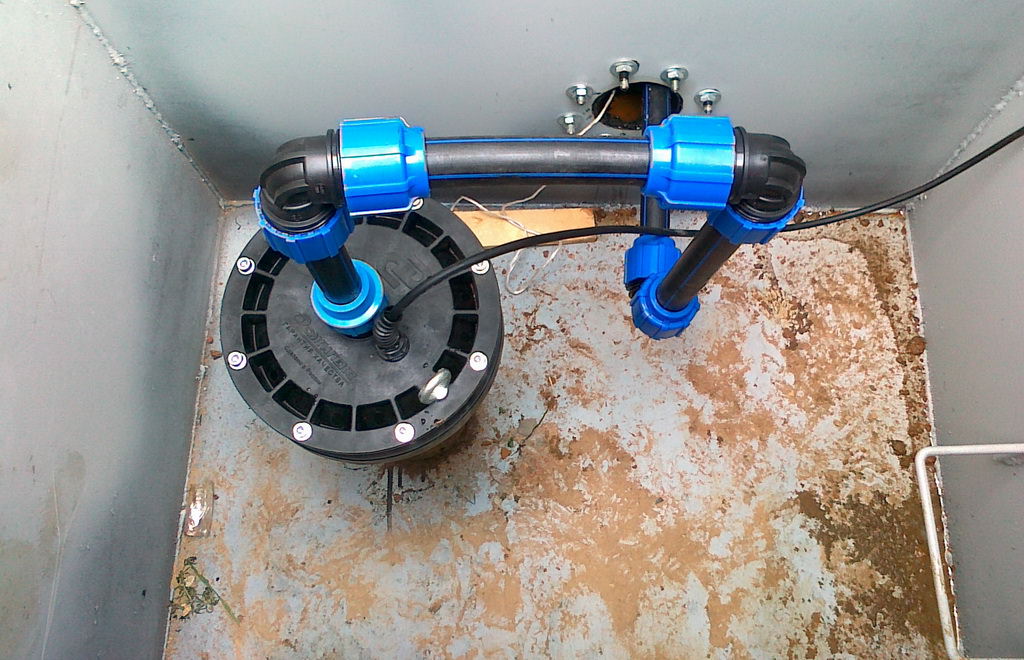
- Laying of temporary water pipelines (including summer cottages). The flexible pipe of small diameter can be easily coiled after disassembly and put away for storage.
A special case
A little higher, we mentioned that polyethylene pipes are not used for hot water supply.
However, in addition to ordinary polyethylene with its low temperature resistance, two exotic varieties of it are used when installing plumbing equipment:
- Cross-linked polyethylene PE-X... Cross-linking between polymer molecules makes it more heat-resistant (up to 95 ° C) and gives increased mechanical strength;
- Thermally modified polyethylene PE-RT. Its feature is increased resistance to high temperatures up to 110 degrees.

Both polymers are massively used in hot water supply systems (as a rule, with hidden collector wiring of water from the collector to plumbing fixtures) and in heating systems (as pipes for radial wiring and water underfloor heating).

Installation
How is the installation of polyethylene pipes for water supply carried out?
There are three ways to connect pipes:
| Picture | Description |
|
|
Connection on compression fittings: pipes are fixed with union nuts with compression rings; tightness is ensured by a rubber seal. Compression fittings for polyethylene pipes for water supply are up to 110 mm in size; at the same time, pipes up to 32 mm can be assembled with their own hands, without the use of any tools. |
|
|
Electrofusion fittings are designed for socket welding and are equipped with a built-in heating coil. When powered, the plastic of the fitting is reliably fused with the plastic of the pipe. The welding process is fully automated: the welding machine adjusts the voltage and heating time by reading the barcode on the fitting. |
|
Installation of a butt joint on the main water supply |
Butt welding is used for pipe wall thicknesses over 4 millimeters. The ends of the pipes to be connected are pressed against the heating element (mirror) and melted, and then connected with each other with a pressing force of about 1.5 kg / cm2. The strength of the seam is approximately 80% of the strength of a single piece of pipe. |
Which connection method should you use? The instructions are pretty obvious:
- When installing the bushing on a private house or suburban water supply, inexpensive compression fittings that leave the connection collapsible should be preferred;
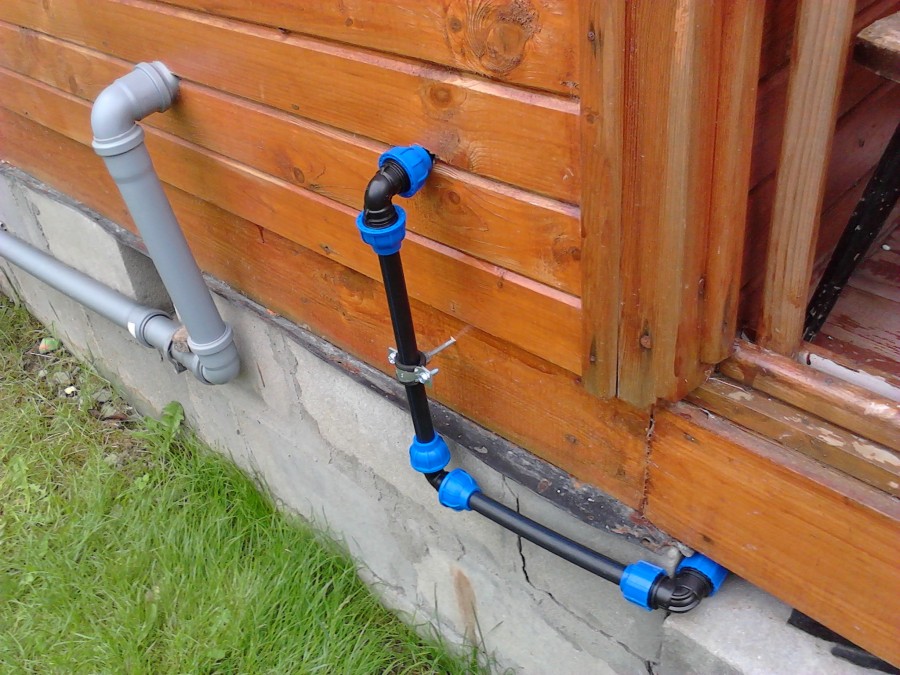
- Water supply lines are butt-welded;
- Expensive but providing maximum strength connections electrofusion fittings are needed, first of all, on cold water supply bushings with a small diameter in cases where their configuration does not allow to do without splicing pipes in the ground.
Please note: laying water supply pipelines from pressure polyethylene pipes at a high level groundwater is performed on a sandy substrate that acts as a drainage and excludes frosty heaving of the soil. When backfilling the trench, there should be no large stones or other objects in the soil that could damage the walls of the pipeline.
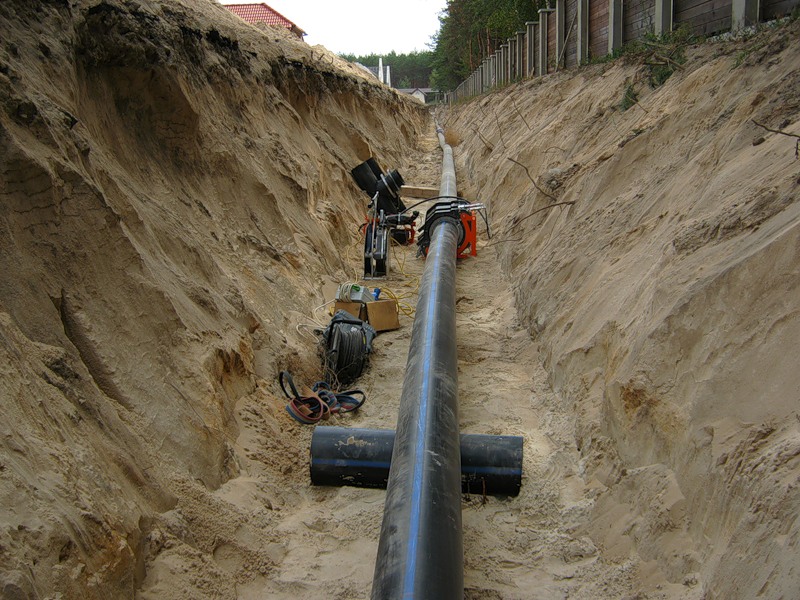
Conclusion
We hope that the reader will find our material interesting and informative. To learn more about how polyethylene pipes and fittings are mounted for water supply, the video in this article will help you. Good luck!
For many years, water pipes were made of cast iron or metal. But progress does not stand still. AT last years pipes made from new materials began to appear on the market. Polyethylene pipes have gained wide popularity.
They have become practically indispensable in water supply. This was facilitated by their properties. It is very easy to install such products, and their cost is available to anyone.
Polyethylene pipes for water supply are widely used in a wide variety of industries:
- installation of a water supply system;
- gas distribution devices;
- sewerage.
In addition, polyethylene pipes serve as a protective box for laying a wide variety of cables. Installation is done in several ways:
- open;
- trenchless method using HDD.
To understand why the polyethylene pipe has become so popular, you need to familiarize yourself in more detail with its properties.
There are several manufacturing options - SDR9, SDR11, SDR13.6, SDR 21 and SDR 26. The abbreviation "SDR" indicates how much the product is able to withstand internal pressure. To obtain it, the outer diameter is divided by the wall thickness. Therefore, if the thickness of the product begins to increase, then this indicator will decrease. In other words, the pipe will be very strong if the SDR value is minimal.
Such polyethylene water pipes are available in several types:
- PE - 80;
- PE - 100.
 The first brand is used when laying a water supply system and sewerage systemwhen the section is less than 90 mm. The second type is used when installing trunk pipelines.
The first brand is used when laying a water supply system and sewerage systemwhen the section is less than 90 mm. The second type is used when installing trunk pipelines.
The plastic from which pipes are made is also divided into groups:
- Food grade:
- Technical.
The material of the latter was secondary raw materials. It is strictly forbidden to use such material for laying household water supply.
When buying pipes for drinking water supply, be careful. The material of such products must be food grade polyethylene approved for domestic water supply. Its contact with water is not dangerous to humans.
They come from the factory in bays from 100 to 1000 meters. Sometimes, for specific cases, coils with a pipe length of 12 meters are supplied.
The use of polyethylene pipes
Since this material has high strength and low weight, they are used in various industries and utilities:
- Water supply construction and repair.
- Hydraulic structures.
- Pools.
- Watering installations.
- Artesian wells.
Such products are used for transportation different types fuel for both industrial and domestic purposes.
The advantages of polyethylene products
The transportation of HDPE pipes, from which the installation of the water supply is made, is several times cheaper than the similar transportation of steel products.
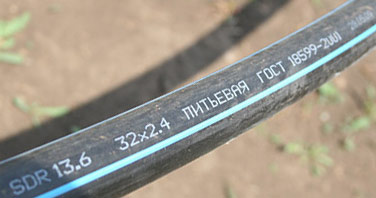 The weight of such a pipe is much less than its metal counterparts. The labor intensity of installation work is much less than the laying of water supply pipelines from pressure polyethylene pipes, so the cost of construction and installation work when using the open method is reduced by 2–2.5 times.
The weight of such a pipe is much less than its metal counterparts. The labor intensity of installation work is much less than the laying of water supply pipelines from pressure polyethylene pipes, so the cost of construction and installation work when using the open method is reduced by 2–2.5 times.
Polyethylene is highly elastic, so it can be easily installed in places where the track makes turns.
The technological process of laying such products makes it possible to use gentle methods:
- narrow trench laying;
- drilling in a certain direction;
- breakout;
- trenchless laying methods.
The use of such technologies helps to reduce the costs associated with installation work. These works do not affect the state of the environment in any way.
The work is carried out in the shortest possible time. Sometimes the installation of a polyethylene system is 10 times faster than the installation of a similar, steel water pipeline.
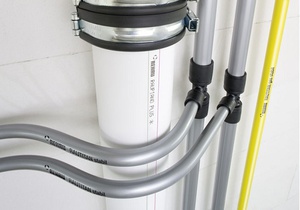 Polyethylene is a material that never corrodes. Such products are highly resistant to aggressive alkaline and acidic environments. This property of polyethylene makes it possible not to insulate pipes and not to carry out additional electrochemical protection.
Polyethylene is a material that never corrodes. Such products are highly resistant to aggressive alkaline and acidic environments. This property of polyethylene makes it possible not to insulate pipes and not to carry out additional electrochemical protection.
The throughput of a water supply polyethylene pipe is 15% more than steel analogs, since it has a completely smooth surface inside.
How to connect products? Their connection does not require welding, there is no need to carry out additional control of welding seams. There is no need to specifically train personnel. No expensive tutorials required:
- welding process technology;
- installation of HDPE.
The assembly of polyethylene pipes does not require various couplings and butt welding.
Special electrofusion devices allow automatic butt welding with minimal error.
disadvantages
With direct exposure to ultraviolet radiation, such products begin to deteriorate. The deformation of the product begins to occur at temperatures exceeding 65 degrees. Therefore, these products cannot be used in heating systems.
If such products are used in industrial systems, nitric acid must not be passed through them. A chemical reaction occurs, the result of which is the destruction of the walls of this polyethylene pipe.
Choosing polyethylene pipes
Water pipes are made from several grades of polyethylene:
- PE 80;
- PE 100.
 The second type is much stronger and denser than the first. If you lay a water supply in a private house, then it will be enough to use only PE 80. They are able to work normally at a pressure of 8 atm.
The second type is much stronger and denser than the first. If you lay a water supply in a private house, then it will be enough to use only PE 80. They are able to work normally at a pressure of 8 atm.
For the installation of a water supply system from polyethylene pipes with a safety margin, you can install PE100. These products will freely withstand 10 atmospheres.
When choosing, be sure to pay attention to who was the manufacturer of this product. European manufacturers are distinguished by the production of very high quality products. The reliability of future plumbing systems depends on the performance of these pipes and their accuracy.
Turkish companies produce medium quality products. The cheapest and most unreliable are Chinese manufacturers. The quality of their products is always much lower. Of course, everyone chooses the product they need. It is difficult to advise anything. It all depends on the region and wallet.
How the connection is made
A separate article has been written about the installation of a polyethylene water pipe, here we will touch on this issue in a short form. 
The connection of polyethylene pipes is carried out only with the help of special fittings. These parts can have several types, with sealing rings and without them. Soldering of such products is carried out with a special apparatus. In the absence of fittings, soldering is performed end-to-end.
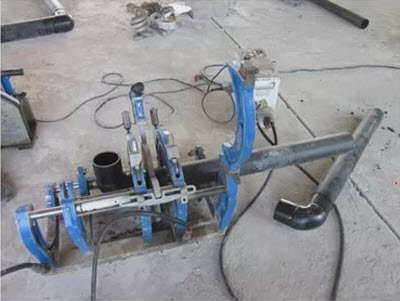
Such welding devices are used mainly by companies involved in installing a plumbing system. This equipment is quite expensive, so it is better to invite a master than to buy such an expensive device for a one-time execution.
How is the installation
No special preparation is required to connect PE products and compression sleeves. Even a beginner can do this work freely. First, the polyethylene pipes for the water supply are cut to the desired size. They are freely sawn with a hacksaw or a special pipe cutter.
The edges at the cut are well cleaned. A small chamfer is made along the entire diameter.
Coupling parts are put on the pipes, observing a certain sequence. The ends of the parts are inserted into the body of the fitting. The connection is tightened securely.
An illustration is shown below, which in an accessible form shows how a PE connection should be passed, intended for laying a plumbing system.

Rules for installing a polyethylene water pipe
When polyethylene pipes are laid, the depth of the laying must necessarily exceed the depth of freezing of the soil by about 20 cm. If we take the Moscow region, this value reaches about 1.5 meters.
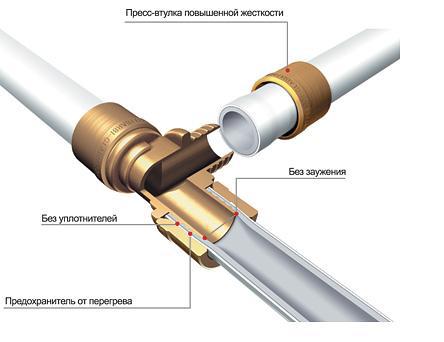 The trench should have a bottom, the width of which exceeds the pipe diameter by 40 cm. If welding will take place directly in the trench, then its width is made such that the welding machine can easily fit.
The trench should have a bottom, the width of which exceeds the pipe diameter by 40 cm. If welding will take place directly in the trench, then its width is made such that the welding machine can easily fit.
To prevent the products from getting damaged before starting installation, the bottom of the trench is well leveled. When the bottom is strewn with solid inclusions, a sand cushion is made. Approximately 10-15 cm layer of sand is covered.
When a trenchless installation of a water supply is done, there is no need to make a base and carry out backfilling. After the installation is completely completed, backfilling is imperative. First, a layer of sand is poured, which closes the pipe about 15-30 cm above its top point.
Then the trench is filled up with any suitable materialeg stones, you can use construction waste.
In the case of laying a polyethylene water pipe under roads, backfilling is done only with sand, each time compacting its layer.
approximate cost
HDPE water pressure pipes made of polyethylene PE 100
![]()
HDPE water pressure pipes made of polyethylene PE 80

|
|
|
LOCAL RESOURCE STATEMENT GESN 16-04-002-04
| Name | unit of measurement |
| Laying of water supply pipelines from medium-type low-pressure polyethylene pressure pipes with an outer diameter of 40 mm | 100 m pipeline |
| Scope of work | |
| 01. Part marking and pipe cutting. 02. Assembly of units from individual parts and fittings with preparation for resistance welding. 03. Laying of pipelines by welding and glue from ready-made units. 04. Installation of coupling fittings. 05. Installation of mountings with pistol sighting. 06. Hydraulic test pipeline and flushing with water. | |
PRICE VALUES
The price includes only direct costs of work for the period 2000 year (Federal prices), which are calculated according to the norms of the HPES of the issue 2009 year... For further application, the conversion factor to current prices is applied to the specified price.
You can go to the pricing page, which is calculated based on the standards of the 2014 edition with additions 1
To determine the composition and consumption of materials, machines and labor costs, GESN-2001 was used
EMPLOYMENT
| № | Name | Unit Rev. | Labor costs |
| 1 | Labor costs of construction workers Category 4.2 | person-h | 162,4 |
| 2 | Labor costs of drivers (for reference, included in the price of EM) | person-h | 5,9 |
| Total labor costs of workers | person-h | 162,4 | |
| Workers' pay \u003d 162.4 x 9.91 | Rub. | 1 609,38 | |
| Remuneration for machinists \u003d 83.25 (for invoicing and profit) | Rub. | 83,25 | |
OPERATION OF MACHINES AND MECHANISMS
| № | Cipher | Name | Unit Rev. | Consumption | Unit st. Rub. |
Total Rub. |
| 1 | 020129 | Tower cranes when working on other types of construction 8 t | machine-h | 0,06 | 86,4 | 5,18 |
| 2 | 021141 | Truck cranes when working on other types of construction 10 t | machine-h | 0,04 | 111,99 | 4,48 |
| 3 | 081600 | Aggregates for welding polyethylene pipes | machine-h | 5,8 | 100,1 | 580,58 |
| 4 | 400001 | Flatbed vehicles, carrying capacity up to 5 t | machine-h | 0,31 | 87,17 | 27,02 |
| Total | Rub. | 617,27 | ||||
CONSUMPTION OF MATERIALS
| № | Cipher | Name | Unit Rev. | Consumption | Unit st. Rub. |
Total Rub. |
| 1 | 101-0137 | Dowels with a calibrated head (in cages) 3x58.5 mm | t | 0,00103 | 22558 | 23,23 |
| 2 | 101-0329 | Glue 88-CA | Kg | 0,23 | 28,93 | 6,65 |
| 3 | 101-1680 | Construction and assembly gun cartridges | 1000 pcs. | 0,121 | 253,8 | 30,71 |
| 4 | 101-9107 | Handpieces | Kg | 0,66 | 0 | 0,00 |
| 5 | 103-9140 | Coupling fittings | PC. | 0 | 0 | 0,00 |
| 6 | 113-0473 | Methylene chloride | Kg | 0,29 | 11,8 | 3,42 |
| 7 | 301-9240 | Mountings | Kg | 0 | 0 | 0,00 |
| 8 | 302-9911 | Shaped and connecting parts for polyethylene pipes | PC. | 0 | 0 | 0,00 |
| 9 | 405-1601 | Chlorine quicklime construction lime, grade A | Kg | 0,0063 | 2,15 | 0,01 |
| 10 | 411-0001 | Water | m3 | 1,88 | 2,44 | 4,59 |
| 11 | 507-9005 | Polyethylene pipes | m | 93,7 | 0 | 0,00 |
| Total | Rub. | 68,62 | ||||
TOTAL BY RESOURCES: RUB 685.89
Security suburban area water is not a whim of its owner or an unnecessary luxury, but an urgent need. Experienced summer residents in any, most severe, conditions try, at the first opportunity, to bring water to their summer cottages in order to be able not only to wash after a working day, but also to give it to garden plants, bushes and garden trees.
Often, members of gardening partnerships and cooperatives unite to create a common water supply system for the entire village. If this is not possible, gardeners-gardeners conduct surveys of aquifers in their own plots, punching wells or digging wells.
Undoubtedly, the revolutionary technology of recent decades has been the use of polymer-plastic pipelines for laying pipelines, in particular, (PE) pipes.
They turned out to be able not only to replace traditional, but also beat them in the competition in many ways, displacing the latter even in the segment of medium-haul pipelines. In addition, it is quite possible to make a country water supply system out of your own hands, the laying technology is quite easy. This will save you money - you don't need to call the master.
Specifications
For the manufacture of pipes operating under a high fluid pressure, it is used, paradoxically, Low pressure PE(HDPE). The term "low pressure" here means manufacturing technology.
AND High pressure PE has a low density at the outlet and in the manufacture of pipes requires additional reinforcement and an increase in thickness, but in the production of film materials it is used very widely.
HDPE pipes are suitable for creating main pipelines of liquids and gases under pressure up to 20, and when reinforced with a nylon mesh - 30 atm.
The number in the PE designation indicates 4 classes of its density: PE100 - the densestfollowed by: PE80, PE63 and PE32.
The markings applied to the pipes show:
- pE brand;
- outer diameter to wall thickness ratio - SDR;
- further: the diameter itself and the thickness of the walls;
- the purpose of the pipe, for example, drinking;
- number of GOST, DIN or other standard.
The main specifications installed on PE pipes ΓOST-s 18599-2001, ISO 161-1-2004, as well as a set of rules SP 40-102-2000.
PE-pipes for water supply and sewerage have blue color or black with a blue stripe... Gas pipelines are marked in yellow. Pipes are produced from polymeric materials coiled in coils, coiled on coils, and for large diameters - in straight lengths from 5 to 24 m.
Advantages
- Durability: up to 50 years old.
- Possibility of multiple assembly-disassembly and reuse.
- High biological and chemical resistance and inertness... Not susceptible to corrosion.
- Indestructible when frozen.
- Low thermal conductivity.
- Greater surface smoothness... Low pressure loss.
- Facilitating movement and assembly work light weight - 5 ~ 7 times lighter than steel.
- High flexibility, firmness and elasticity. Resistance to water hammer.
- Simplicity and low cost of butt weldingthat does not require consumables: electrodes, etc.
- Long lengths of PE pipes in coils or spools - 100 ~ 2000 m allows you to refuse welding or coupling joints in small areas.
- Ease of installation and ease of use.
- Maintainability... Quick replacement of damaged areas.
- Sustainability: non-toxicity and bacteriological safety.
- Low price.
Laying new and replacing existing steel pipelines with PE pipes can save up to 45 ~ 50% in material costs.
disadvantages
- Low temperature resistance: PE starts to melt already at 60 °.
- Not resistant to UV radiation.
For heating and hot water pipes made of "cross-linked PE"that can withstand temperatures up to 90 °.
Water supply schemes
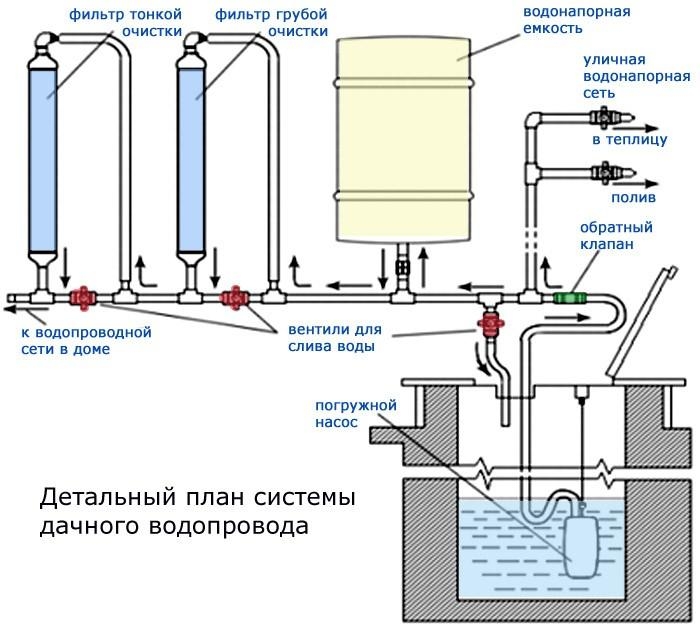
The entire water supply system of the summer cottage can be divided into three sections:
- Water intake: central water supply, well or well.
- External water supply from polyethylene pipes: piping to the house, irrigation system, bathhouse, outdoor shower, etc.
- Internal water supply in the House.
If the dacha cooperative has a central water supply, it can be assumed that half of the problem has already been solved and for the organization of the water supply system, it will only be necessary to lay pipes around the site and in the house. In its absence, it remains find an aquifer and punch a well or dig a well... Each method has its own advantages and disadvantages.
Well or well
Wells are of two types: gravity, up to 50 m deep and artesian - up to 150 m. Drilling an artesian well is an expensive activity and is hardly advisable for 6 or 12 acres, therefore they are not considered here.
- It will not be difficult to get water from the well and with power off, but for a well it is practically impossible.
- Well water is much more at risk of external contamination... Water from the well is taken from a greater depth: it is cleaner.
- Elimination of well silting is easierthan a well that may require new drilling.
- The volume of water in the well is greater, which allows in a system without a storage tanksmooth out the pressure drop at peak load.
- The rise of water from the well is carried out from a shallower depth... This requires a smaller pump.
Local laws in some regions of the Russian Federation require a well permit to be issued even for water use purposes.
Based on the rich experience of summer residents and gardeners, we can conclude: is cheaperand easier to operate.
The next step is to decide on the type of pump.
Submersible or surface
When the system is powered from a well, in most cases preference should be given to a submersible pump, which:
- Does not need conservation for the winter.
- Quiet, does not take up space on the site or in the house.
- Does not require pre-filling with water to get started.
suspended at a depth of 0.8 ~ 1 m from the bottom of the wellon a safety rope.
Then you need to determine the type of pipeline.
Winter or summer
PE-pipes are not afraid of freezing: even if there was water in them, they completely restore their shape after thawing. Nevertheless when preserving for the winter, it is better to drain the water from them... The pipes of the summer water supply system themselves can not be buried, slightly digging in or leaving them on the surface.
When used in winter, the outlet from the well and the laying of the pipeline should be done in a trench below the depth of soil freezing:
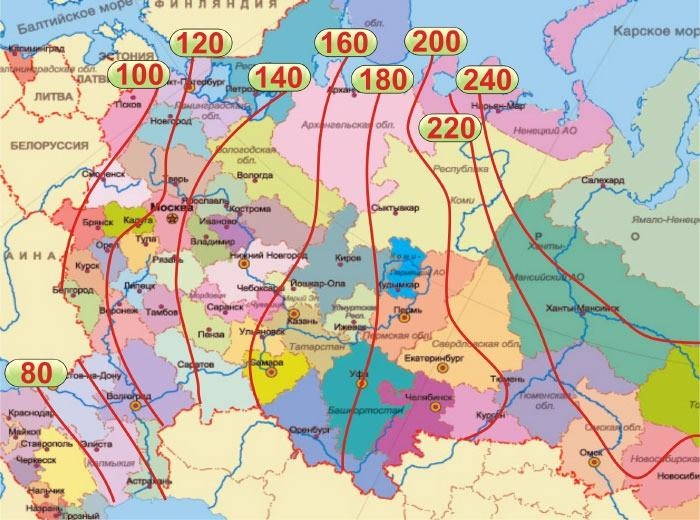
When laying PE pipes in the ground, provide for them a sand cushion of about 10 cm to protect against damage.
With or without storage tank
In the classic water supply system with a storage tank, you can use any container from 50 lhosted in attic or on a special tower. It is also necessary to place a float switch on / off the pump in it. It is imperative to place a non-return valve between the pump and the tank, as well as coarse and fine water filters.

Will not interfere after the check valve install dry running relaythat turns off the pump in the absence of water in the well.
If the water supply will be used by one or two summer residents, then you can apply the scheme without a storage tank... Modern efficient pumps make it possible to do this without any problems, using a diaphragm accumulator tank, which smooths out pressure surges at peak loads.
Damper accumulator tanks are painted in blue colour, and expansion ones for heating - in red.
Internal wiring: with manifold or series

With a large number of water points inside the house the water supply scheme can be performed with a manifold... This will smooth out pressure surges when several consumers are turned on at the same time.
If their number does not exceed 3-4, then the simplest and cheapest option is series "tee" scheme.
Selection of pipes and other materials
Given the low pressure values \u200b\u200bin the suburban water supply systems, optimal diameter of PE pipes - 20 ~ 25 mm... Starting to work on the organization of a water supply system, it is necessary to make a detailed drawing or sketch of the location of water consumers in the house and on the site, calculate the lengths of all sections of the pipeline, the number of fittings for bends and turns, the number of taps, shut-off valves, etc.
Installation of suburban water supply
Compression couplings differ ease and accessibility even for a non-professional:
- The pipes are cut evenly with a special pipe cutter or a fine-toothed hacksaw.
- The cut point is cleaned, a small chamfer is removed on it.
- Collapsible parts of couplings are put on pipes in strict sequence, the ends of which are then inserted into the central part of the fitting and tightened securely.
This illustration shows you how to assemble and connect polyethylene pipes for a water supply system.
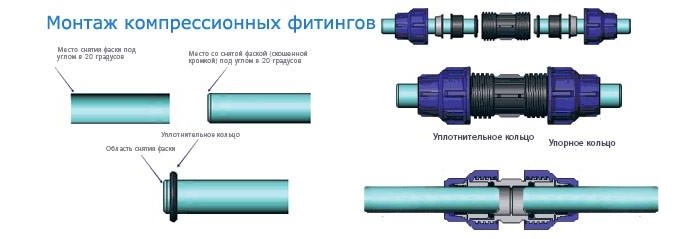
Gone are the days when it was necessary to carry water from a well in the country house to the house or to the garden with buckets: modern construction market offers water supply facilities and systems, affordable, practical and convenient for self-assembly.

